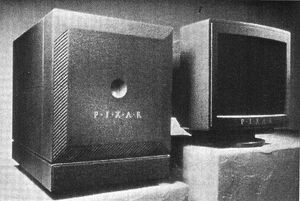
P-II Pixar Image Computer
The Pixar Image Computer (PIC for short) was a graphic designing computer originally developed by the Lucasfilm Computer Division (later renamed Pixar). It was designed for the high-end visualization markets.
History
In 1984, the Lucasfilm Computer Division showed off the prototype of the Pixar Image Computer at the SIGGRAPH computer graphics conference, in addition to a partially-completed version of The Adventures of André & Wally B. having premiered there.
Released commercially for the first time on February 3rd, 1986, the Pixar Image Computer was intended for commercial and scientific high-end visualization markets, such as media production and medicine. It had a price tag of $135,000, but it had also required a $35,000 workstation from Sun Microsystems or Silicon Graphics to operate it. It proved to be ahead of its time, and had generated a lot of single sales. However, it did not sell in quantity.
In 1987, Pixar developed the second-generation Pixar II (P-II for short) image computer, a low-cost model which sold for $30,000.
In an attempt to gain a foothold in the medical market, Pixar donated ten machines to leading hospitals and sent marketing people to doctors' conventions. However, this had little effect on sales, despite the machine's ability to perform CAT scans and show perfect images of the human body. Pixar did get a contract with the manufacturer of CAT Scanners, which sold 30 machines. The terms were: Buy a million-dollar scanner, and get a $30,000 3D visualization system free. However doctors were not trained to look at 3D, and could be sued unless they looked at the individual slices, per their training. By 1988, Pixar had only sold 120 Pixar Image Computers.
In 1988, Pixar began the development of the PII-9, a nine-slot version of the P-II. This machine was coupled with the world's first RAID (Redundant Array of Independent Disks) assembly, a high performance bus, a hardware image decompression card, four Channel Processors (or Chaps), very large memory cards (VME sized card full of memory), high resolution video cards with 10-bit DACs which were programmable for a variety of frame rates and resolutions, and finally, an overlay board which ran the NeWS windowing system, and the 9-slot chassis. A full-up system was quite expensive, as the 3 GiB RAID was $300,000 alone. At this time in history, most file systems could only address 2 GiB of disk.
This system was aimed at high-end government imaging applications which were done by dedicated systems produced by the aerospace industry, which cost a million dollars a seat. The PII-9 and the associated software became the prototype of the next generation of commercial "low cost" workstations.
In 1990, the Pixar was defining the state-of-the-art in commercial image processing; however, the government decided that the per-seat cost was still too high for mass deployment, and to wait for the next generation systems to achieve cost reductions. This decision was the catalyst for Pixar to lay off its hardware engineers and sell the imaging business. There were no high volume buyers in any industry. Less than 300 Pixar Image Computers were ever sold.
The Pixar Image computer business was sold to Vicom in 1990 for $2,000,000. Vicom filed for Chapter 11 within a year. Many of the lessons learned from the Pixar Image Computer had transitioned into the Low Cost Workstation (LCWS) and Commercial Analyst Workstation (CAWS) program guidelines in the early and mid '90s. The government mass deployment that drove the PII-9 development occurred in the late 1990s, in the Integrated Exploitation Capability (IEC) program.
Trivia
- Walt Disney Feature Animation, whose parent company later purchased Pixar in 2006, used dozens of the Pixar Image Computers for CAPS and was using them in production up through Pocahontas in 1995.
- The Pixar Image Computer was only used on one Pixar film - the dream sequence of Red's Dream. It turned out the Reyes rendering system was too complex for the computer so had to be trimmed down to basic functions so it could work.
